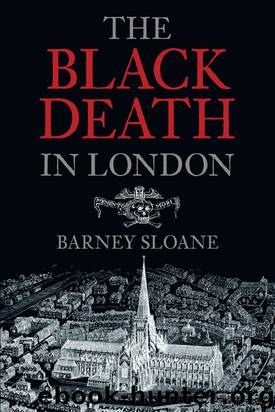The Black Death in London by Barney Sloane

Author:Barney Sloane
Language: eng
Format: epub, mobi, pdf
ISBN: 9780752496399
Publisher: The History Press
Published: 2013-04-11T16:00:00+00:00
Four
PESTILENCE IN LATER
FOURTEENTH-CENTURY
LONDON
Pestis Secunda, 1361
Secunda mortalitas. Eodem anno mortalitas generalis oppressit populum que dicebatur Pestis Secunda. Et moriebantur tam maiores quam minores, et maxime iuvenes et infantes.
The second mortality. That same year a widespread mortality, known as the Second Plague, overwhelmed the people. And the great were killed along with the masses, and especially infants and the young.362
Anno xxxv (Edward III): And that same yere men, bestys, treys, and howsys were smyght fervently with lytthenyge, and sodenly i-peryschyde. And they fonde in mennys lyckenys splatt men goyng in the waye.
The 35th year (Edward III): And in that same year, men, beasts, trees and houses were smitten violently with lightning and suddenly perished. And fiends in the likeness of men accosted men as they went their way.363
Mesme celle ane fuist la secunde pestilence parmy Engleterre la quel fuist appelle la mortalites des enfauntz.
That same year was the second pestilence in the country of England which was called the mortality of the infants.364
Such are the chronicles of the events in 1361, but there is a short foreword to this second disaster in which London may have been visited by some kind of outbreak as early as the autumn of 1360. The Chronicle of the Greyfriars of King’s Lynn notes: ‘In that year [1360] began a plague among Londoners at about the feast of St Michael, where at first infants died in huge numbers.’365 This lone reference has, perhaps, the feel of a scribal error about it, and might best be conflated with the main outbreak of 1361, but we cannot actually tell. Apart from the fact that a disease initially affecting the young would be unlikely to be well represented in evidence from wills, the wills themselves do not survive for this specific time: roll 88 of the Husting court, dating to between January 1360 and February 1361, is missing.366 Of the wills drawn up in 1360, we have just ten which happened to be proved in March 1361 or later when the sequence resumes, and none of these offer any clue about such an outbreak. Additionally, among charters from Colchester, Essex, is one from 1410 which notes a will from 34 Edward III (so January 1360 to January 1361) at the time of the secunda pestilencia.367 It remains possible, therefore, that a plague, one which affected the young, did strike the city in the last months of 1360.
There is, however, no doubt about the events of the following spring. The greyfriars of Lynn may be quoted again:
and after the next Easter following [April 1361], men and women died in great multitudes … In that year the plague raged in the southern parts of England with great mortality among children, youths and the wealthy. This plague was however much less serious than that which had befallen thirteen years before.368
This report is backed up by most other contemporary chroniclers. As well as Henry Knighton (above), the Anonimalle Chronicle called it the mortality of children, and states that several people of high birth and a great number of children died.
Download
The Black Death in London by Barney Sloane.mobi
The Black Death in London by Barney Sloane.pdf
This site does not store any files on its server. We only index and link to content provided by other sites. Please contact the content providers to delete copyright contents if any and email us, we'll remove relevant links or contents immediately.
| Africa | Americas |
| Arctic & Antarctica | Asia |
| Australia & Oceania | Europe |
| Middle East | Russia |
| United States | World |
| Ancient Civilizations | Military |
| Historical Study & Educational Resources |
Underground: A Human History of the Worlds Beneath Our Feet by Will Hunt(12026)
Sapiens by Yuval Noah Harari(5294)
Navigation and Map Reading by K Andrew(5111)
The Sympathizer by Viet Thanh Nguyen(4307)
Barron's AP Biology by Goldberg M.S. Deborah T(4100)
5 Steps to a 5 AP U.S. History, 2010-2011 Edition (5 Steps to a 5 on the Advanced Placement Examinations Series) by Armstrong Stephen(3691)
Three Women by Lisa Taddeo(3355)
Water by Ian Miller(3129)
The Comedians: Drunks, Thieves, Scoundrels, and the History of American Comedy by Nesteroff Kliph(3040)
Drugs Unlimited by Mike Power(2545)
A Short History of Drunkenness by Forsyth Mark(2235)
DarkMarket by Misha Glenny(2162)
The House of Government by Slezkine Yuri(2159)
And the Band Played On by Randy Shilts(2131)
The Library Book by Susan Orlean(2042)
Revived (Cat Patrick) by Cat Patrick(1963)
The Woman Who Smashed Codes by Jason Fagone(1929)
Birth by Tina Cassidy(1864)
The Absolutely True Diary of a Part-Time Indian by Sherman Alexie(1859)
